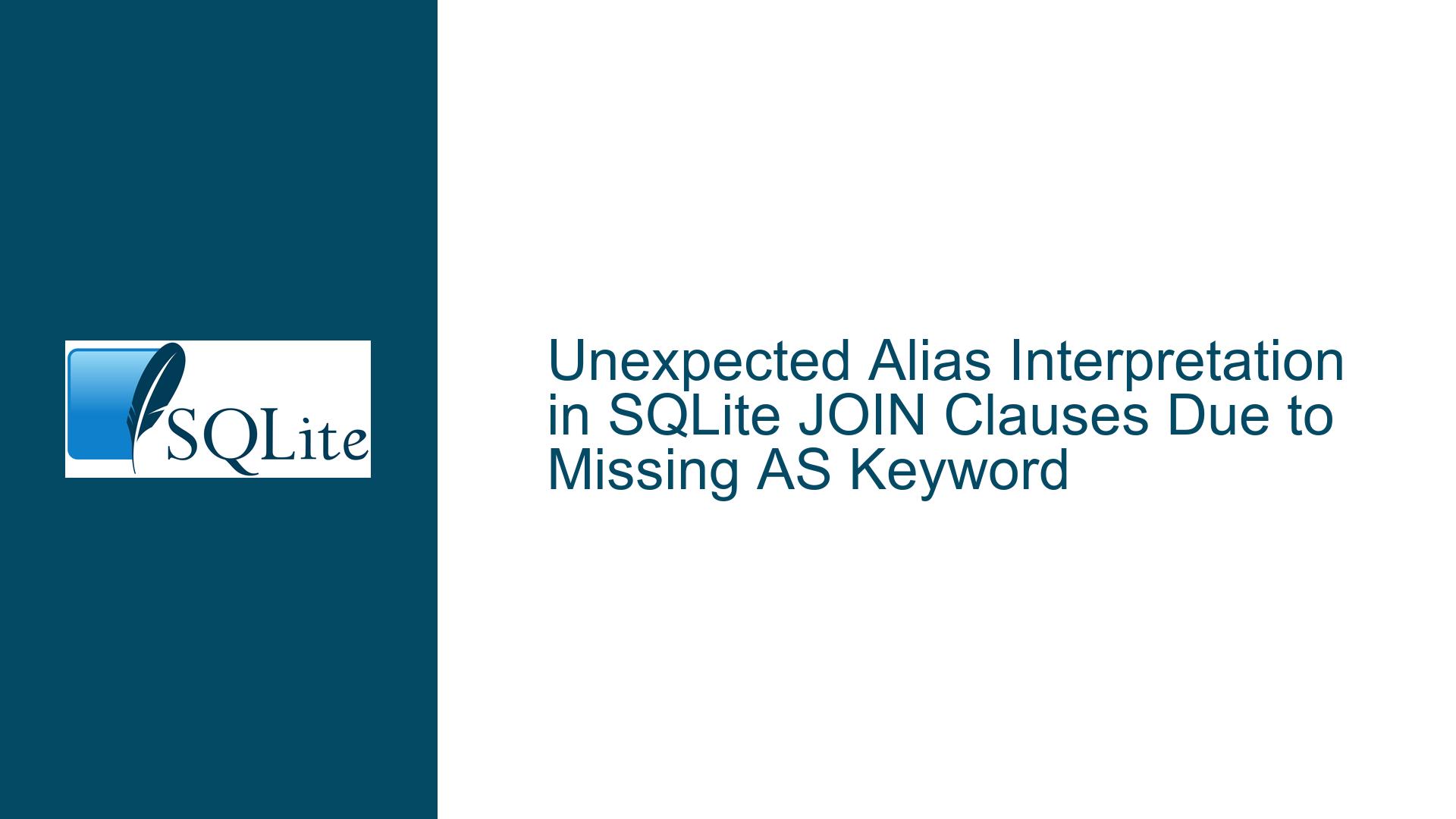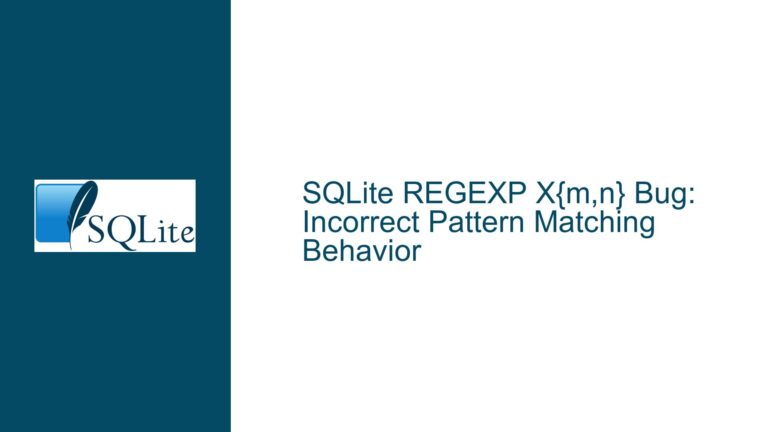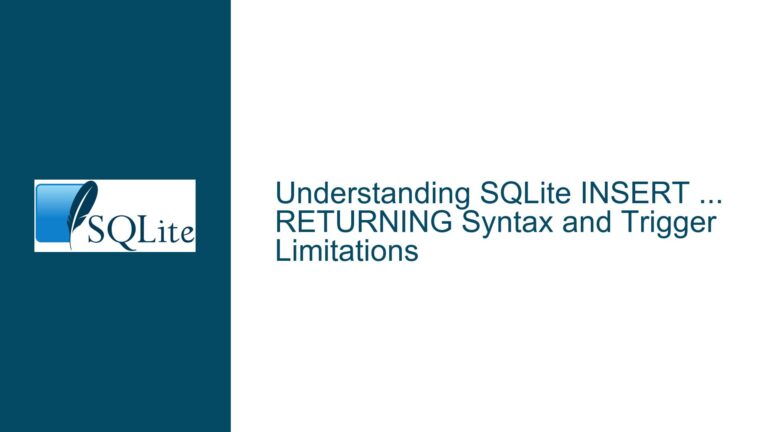Unexpected Alias Interpretation in SQLite JOIN Clauses Due to Missing AS Keyword
Issue Overview: SQLite Silently Treats Invalid JOIN Modifiers as Table Aliases
A common point of confusion when working with SQLite arises from its handling of JOIN clauses that appear to contain invalid or unrecognized keywords. For example, a query structured as SELECT * FROM t1 arbitrary_text JOIN t2 executes without errors, treating arbitrary_text as a valid component of the syntax. This occurs even when arbitrary_text is not a recognized SQLite keyword or JOIN operator (e.g., NATURAL, LEFT, FULL). The resulting behavior mirrors a standard JOIN operation between t1 and t2, as though the extraneous term were absent.
This behavior stems from SQLite’s parsing logic for table aliases and JOIN clauses. Unlike other SQL dialects, SQLite allows omitting the AS keyword when defining table aliases. Consequently, any term placed between a table name and a JOIN keyword is interpreted as an alias for the preceding table. If the term is not a reserved keyword or a valid JOIN modifier, SQLite assumes it is an alias. This can lead to unintended behavior when developers misspell JOIN operators (e.g., writing NATURALL instead of NATURAL) or inadvertently insert extraneous text into the JOIN clause.
The confusion is exacerbated by the absence of explicit errors or warnings. SQLite’s parser does not flag unrecognized terms in this position as invalid syntax because they conform to the rules for alias declarations. This creates a silent failure mode where queries execute with incorrect logic, potentially returning unexpected results without obvious indications of a problem.
Possible Causes: Ambiguous Syntax Rules for Table Aliases and JOIN Operators
The root cause of this issue lies in the interplay between SQLite’s alias syntax and JOIN clause parsing. To understand why this occurs, we must examine three key elements of SQLite’s syntax rules:
Optional
ASKeyword for Aliases: SQLite permits table aliases to be defined without theASkeyword. For example,SELECT * FROM t1 aliasis equivalent toSELECT * FROM t1 AS alias. This flexibility allows developers to write more concise code but introduces ambiguity when aliases are placed near JOIN clauses.Table-Or-Subquery Syntax: The structure of a
FROMclause in SQLite is defined by the<table-or-subquery>grammar rule (documented at sqlite.org/syntax/table-or-subquery.html). This rule allows a table name to be followed by an optional alias, then an optionalINDEXED BYorNOT INDEXEDclause, and finally aJOINkeyword. When a term appears between the table name andJOIN, SQLite first checks if it is a valid alias. If the term is not a reserved keyword, it is parsed as an alias.Lack of Contextual Keyword Validation: SQLite does not enforce strict validation of keywords in all syntactic contexts. Terms like
NATURALorFULLare only recognized as JOIN modifiers when they appear immediately before theJOINkeyword. If a misspelled or invalid term is inserted in this position, SQLite defaults to treating it as an alias rather than raising an error.
This combination of flexible alias syntax and permissive parsing creates scenarios where malformed JOIN clauses are misinterpreted. For instance, in SELECT * FROM t1 NATURALL JOIN t2, the misspelled NATURALL is parsed as an alias for t1, and the query becomes a plain JOIN between t1 (aliased as NATURALL) and t2.
Troubleshooting Steps, Solutions & Fixes: Resolving Misparsed JOIN Clauses and Preventing Ambiguity
To address this issue, developers must adopt strategies that eliminate ambiguity in JOIN clauses and ensure SQLite interprets their queries as intended. Below are actionable steps to diagnose, resolve, and prevent such problems:
Step 1: Validate JOIN Clause Syntax Against SQLite’s Grammar Rules
Review the structure of your JOIN clauses using SQLite’s official syntax diagrams. For <table-or-subquery>, the valid sequence is:
<table-name> [<alias>] [INDEXED BY <index-name> | NOT INDEXED] [<join-operator>]
If a term appears between the table name and JOIN, confirm whether it is intended to be an alias or a JOIN modifier. If it is meant to be a JOIN modifier (e.g., NATURAL), ensure it is spelled correctly and positioned immediately before JOIN.
Example:
- Incorrect:
SELECT * FROM t1 NATURALL JOIN t2 - Correct:
SELECT * FROM t1 NATURAL JOIN t2
Step 2: Explicitly Use the AS Keyword for Aliases
To avoid ambiguity, always include the AS keyword when defining table aliases. This makes it clear to both the parser and human readers that the term is an alias, not a JOIN modifier.
Example:
- Ambiguous:
SELECT * FROM t1 alias JOIN t2 - Unambiguous:
SELECT * FROM t1 AS alias JOIN t2
Step 3: Use Parentheses to Isolate JOIN Clauses
Wrap JOIN operations in parentheses to explicitly define their scope. This forces SQLite to parse the JOIN clause as a discrete unit, reducing the risk of misinterpreted aliases.
Example:
SELECT *
FROM (t1 AS alias1 JOIN t2 AS alias2 ON alias1.id = alias2.id)
JOIN t3 ON alias2.id = t3.id;
Step 4: Test Queries with EXPLAIN to Reveal Parsing Behavior
Use SQLite’s EXPLAIN command to inspect how the parser interprets your query. The output will show whether a term is treated as an alias or a JOIN modifier.
Example:
EXPLAIN SELECT * FROM t1 arbitrary_text JOIN t2;
In the resulting bytecode, look for operations that reference t1 with an alias. If arbitrary_text appears as an alias, you have confirmation of the parser’s interpretation.
Step 5: Enable Strict SQL Mode or Use Linting Tools
SQLite’s "strict" mode (introduced in version 3.37.0) enforces stricter type checking but does not directly address this issue. Instead, use third-party SQL linters or IDE plugins that flag unrecognized keywords in JOIN clauses. Tools like sqlfluff or prettier-sql can highlight potential typos or syntax ambiguities.
Step 6: Educate Teams on SQLite’s Alias Parsing Quirks
Ensure that all developers working with SQLite are aware of the optional AS keyword and its implications for JOIN clauses. Document common pitfalls in team guidelines and conduct code reviews with a focus on JOIN syntax.
By systematically applying these steps, developers can prevent misparsed JOIN clauses and ensure their SQLite queries behave as expected. The key takeaway is to embrace explicit syntax (e.g., always using AS for aliases) and leverage tooling to catch subtle errors before they impact production systems.






